I was in Brussels on November 22, 2011, to give a talk at TEDx Brussels at the Bozar building in Brussels.
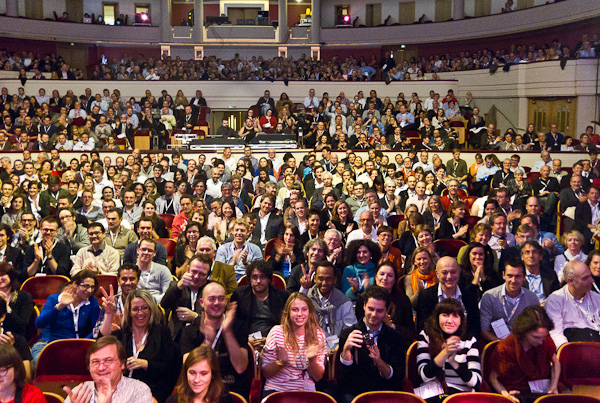
Here’s a photo I took of the audience after the talk.
A video of my talk went online as of November 24, 2011. And I’ve embedded the video here.
***
The rest of this post consists of the slides and the outline of the fifteen-minute talk.

In this talk I speculate about the year 3000. A thousand years from now.
I first came to Brussels here in 2000 to do some research for my novel about Peter Bruegel’s life, As Above So Below: A Novel of Peter Bruegel. And in 2002, I was here as a guest of the Royal Flemish Academy of Belgium for Science and the Arts.

The picture shown above is called The Beekeepers. It’s disturbing and surreal. Bruegel drew this image in 1568, shortly after the patriots, the Count of Egmont and the Count of Hoorne were beheaded at behest of the Spanish Inquisition. My sense is that those straw hives represent the baskets into which Count Egmont’s and Count Hoorne’s heads dropped after being lopped off by the executioner’s sword in the Grand Place.
The image has some relevance to my talk, as a human head, is after all, a rather compact and intense information storage device, and I’ll be discussing the notion of a “lifebox” model of a human personality.
.jpg)
I got a Ph. D. in mathematics, and I’ve published popular science books about infinity and about the fourth dimension. I spent about twenty years as a computer science professor at San Jose State. And over the last ten years I’ve become something of a painter—and you’ll see some of my pictures here. But the the main thing I do is to to write science fiction novels. By now I’ve published twenty of them.
In 1982, I published my early cyberpunk novel, Software. The book introduced a theme I’ve been thinking about for my whole career. Is it possible to copy a person’s personality and essence into another medium? In Software, my notion was that some helpful robots were copying people’s brains by slicing them up—extracting the human software. And the software was being put onto robot bodies. That woman on the cover is an android, you understand. Software and three follow-up novels are available now as the Ware Tetralogy.
I do see this as being something that will happen in the next thousand years. In the very near term, we already have a simple way for mimicking the process, something that I call lifebox software. The idea behind a lifebox is get a large and rich data base with a person’s writings, videos of them, interviews, and so on. That’s the back end. The front end of a lifebox is an interactive search engine. This will be a huge commercial business soon. I’ve even made a preliminary attempt at a Rudy’s lifebox.
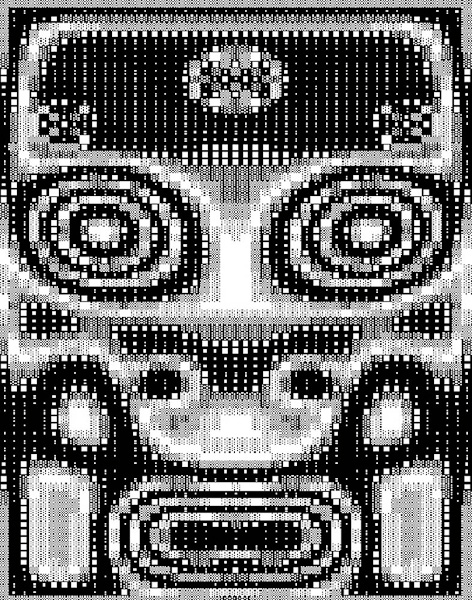
Back in the mid 1980s, I became fascinated with a new style of parallel programs called cellular automata or CAs. I learned about them from Stephen Wolfram. I was interested in his remarks that some cellular automata are universal computers.
I wrote this early CA in assembly language, and the display is made of ASCII characters. I call this particular CA Maxine Headroom after the then-popular animatronic TV character Max Headroom. You can get this program as part of the free Cellab software online.
Although I was getting my novels published I wasn’t earning enough money to support myself, my wife and our three children. I decided to get into computer science. Even though my Ph. D. was in mathematical logic, in 1986 I was able to get a job as a computer science professor at San Jose State University in California.
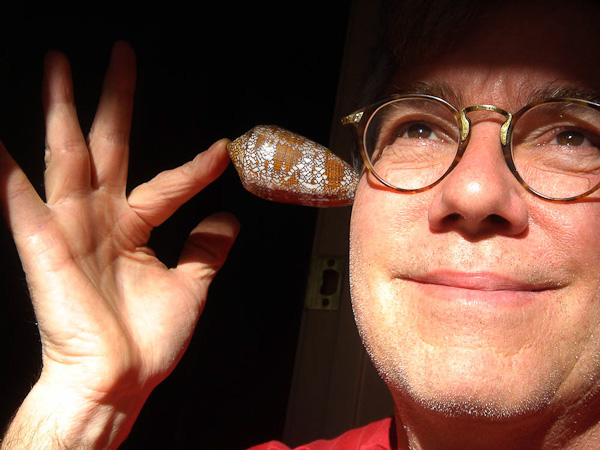
In principle any universal computer can emulate a human mind. And many natural systems behave like cellular automata. So I began wondering if there might be some way to have natural objects become programmable in an easy way.
Above is an image of me clowning with a South Pacific cone shell. The cone shells are beloved by fans of cellular automata, as it’s widely believed that the shells’ patterns are generated by a biological process very similar to a cellular automaton. Here I’m imagining that the cone shell will somehow connect to my brain.
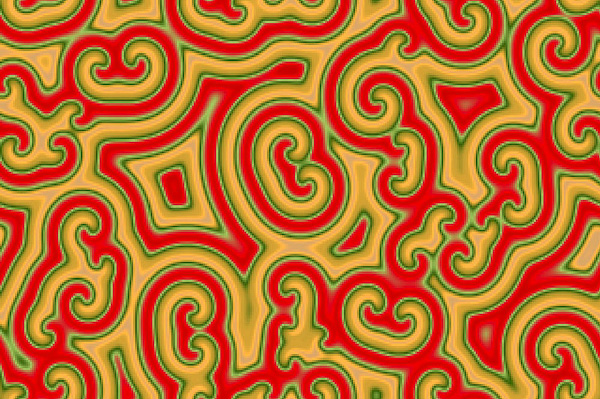
In the years to come, I got ever more involved involved with CAs. The way they work is that, in a CA, you can think of the onscreen pixel as being a little computer, with all of them updating in parallel. One trick that I liked to use continuous values for the states of these pixels or cells, see my free software CAPOW, available online.
Perhaps my favorite CAs are the ones that spontaneously take on the appearance of ever-turning nested scrolls. These guys are called Belousov-Zhabotinsky scrolls, They’re are common in physics—as patterns of turbulent wakes. And they’re ubiquitous in biology—you find Zhabotinsky scrolls in mushroom caps, shells, beans and fetuses. Some have argued that everything in the world is a CA.
I spent hundreds and hundreds of hours staring at CAs. I was always looking for the gnarly ones, that is the CAs whose pattern is nicely positioned between order and randomness. I like using the more California word “gnarly” instead of “complex” or “chaotic.”
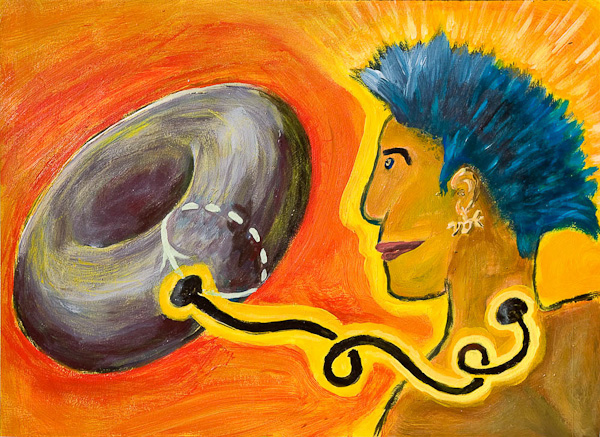
Working as a programmer, I learned the frustration of working with the brittle computing machines. If you omit a semi-colon in a novel, the novel doesn’t disappear—as can happen with a program.
Thinking as a science-fiction writer, I liked to imagine having a completely smooth interface between myself and the outer world—which I’ve painted as a torus here. I was still thinking in terms of a cable into my spine at this point. You can see all of my paintings online.
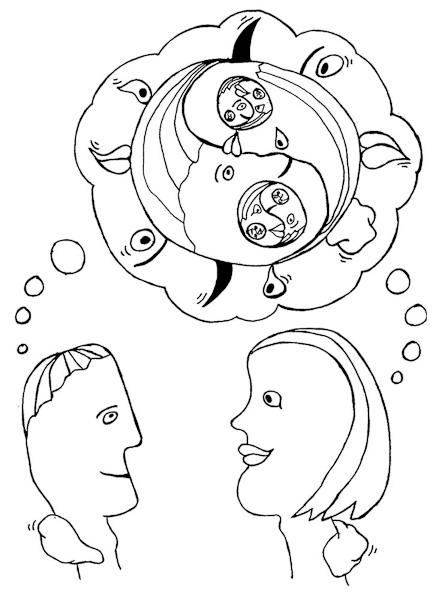
Where will end up in a century or two will be a device that sits on the back of your neck and communicates with other people via their devices. I call these things uvvies in my science fiction novels.
An uvvy link is very close to telepathy. I think we’ll get true telepathy when, instead of sending information to someone else, you simply send them a link to the location where that information is stored in your own brain. And they can access it there without copying it. Relative to you, other people are part of your data cloud.
This picture shows a pathological regress you might encounter with telepathy. Like pointing a video camera at its output screen. An infinite regress. But there’s nothing really wrong with that kind of experience. It might even be fun. This drawing and the ones to follow are taking from my novel, Saucer Wisdom.
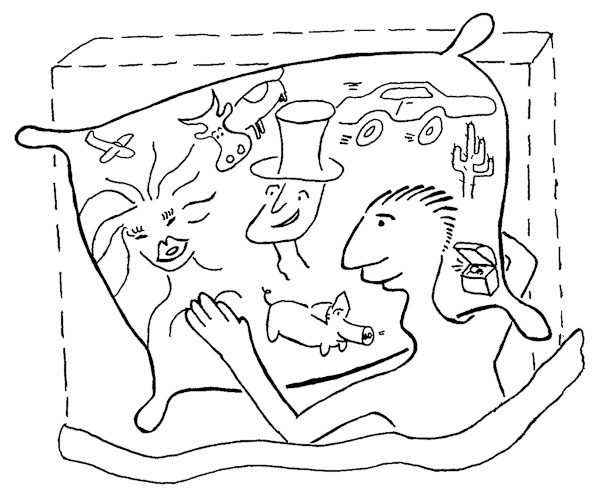
At this point I was getting more and more interested in biocomputation. I think an uvvy might well be a biotech device—probably you want anything that interfaces that closely with your body to be alive.
A much easier biocomputation app we’re likely to see is a substance similar to the skin of a cuttlefish. Call it squidskin for short. We’ll be using squidskin as an inexpensive all-purpose display. This guy has a squidskin pillow so he can look at nice things in bed.
I like to use the word wetware when talking about hacking genomics. I’m taking wetware to mean the genomic information that generates a living organism. An acorn is the wetware for an oak tree, an egg is the wetware for a chicken, a person’s wetware is their DNA.
I don’t see nanotech as a separate discipline. It’s really about learning to work with the biotech already present in nature. To become a wetware engineer.
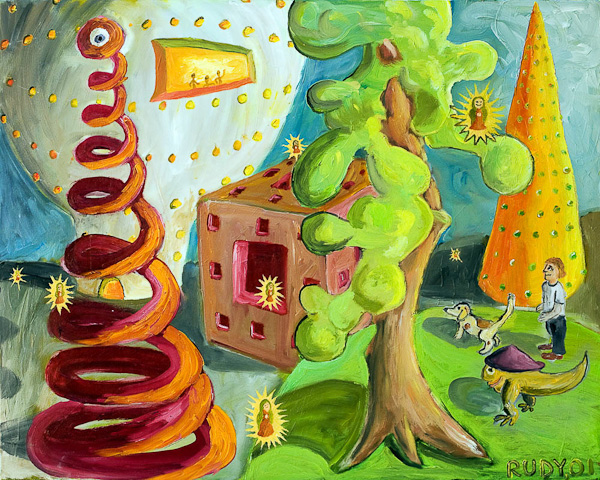
Looking towards the year 3000, I expect that we will have gotten very good at wetware engineering. This painting show a future city in which all of the buildings—except for that tree in front—have been grown.
Note also the Bosch-style little man in the lower corner. And the floating little figures might be taking the place of surveillance cameras. For some reason each of them shaped like the Virgin Mary. This painting was made for my novel Frek and the Elixir, which is set in the year 3003.
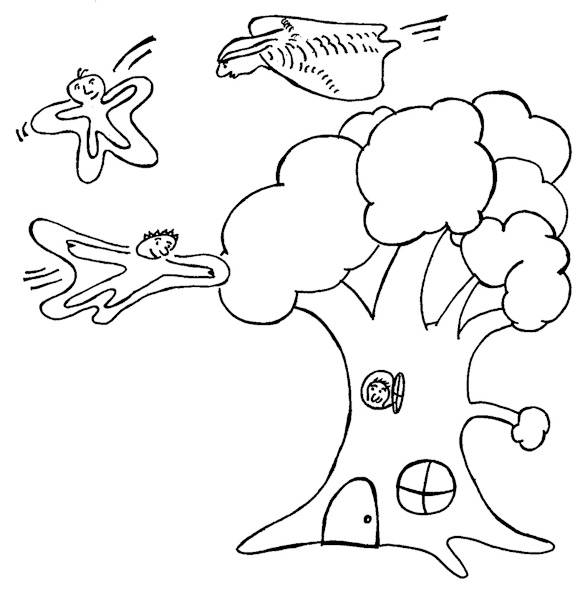
Naturally we’d like to grow our own houses. I think of a seed about the size of a pizza, and you shove it in the ground. I like the idea of a family living inside a kind of oak tree with squidskin on the inner walls.
I see the tree as being powered off photosynthesis. It has toilets in the walls that feed into the tree’s metabolism. It extracts metal from the ground and grows an electrical circuit, in case we’re still using electricity. The internal plumbing system extracts water from a tap-root that grows down to the water table.
The people have symbiotic wings they can strap on. I know there’s an energy problem in human flight—we’ll assume the wings are powered with, let us say, dark matter.
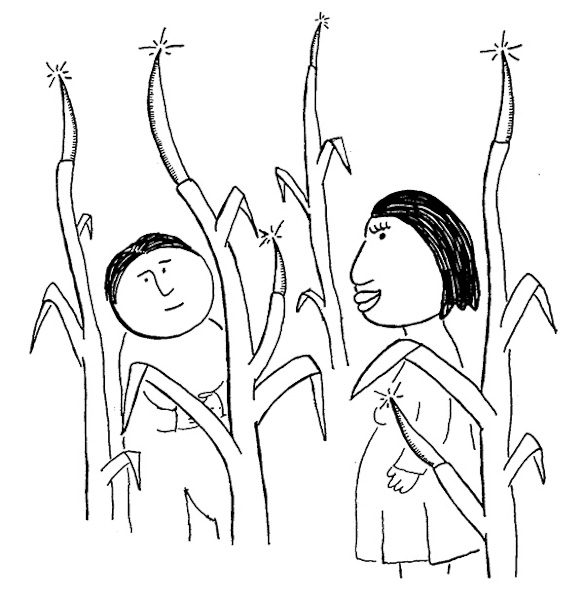
We can expect wetware engineered plants to grow any kinds of objects that we need. Here you see a plant like a corn stalk, except it extracts iron from the soil and forms a knife at its tip. A stub of the stalk makes a nice handle.
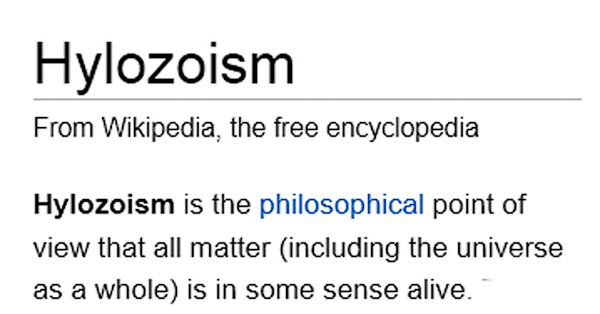
In the early 2000s, I became interested in the notion of moving beyond biocomputation as well If we take seriously the notion of quantum computation, anything at all can be a computer.
The notion that I’m leading up to is hylozoism. This is a real word, you can find it in Wikipedia. I got so enamored of this word that I even wrote a novel called Hylozoic, in which everything is alive—even the rocks.
A stone is, after all, like a jiggling mass of a septillion atoms, connected by spring-like bonds. There’s a lot happening inside a rock. Why shouldn’t it be as intelligent as I am?
In a hylozoic society of the year 3000, we don’t use manufactured tools anymore.
Instead we directly program the material objects around us. Every object is filled with quantum wave functions. Every object is programmable. Every object is alive. You only have to tell it what to do.
And how do you talk to the objects? Via our uvvies—that is, via something like telepathy.
Here’s a matching pair of images—just for fun.
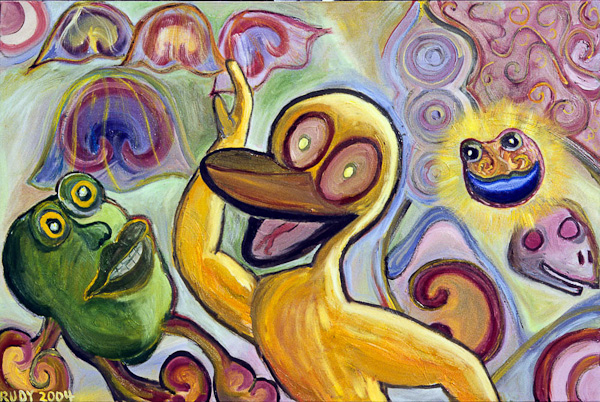
This painting shows a weird scene in our biocomputational future. Think of it as a year 3000 disco.
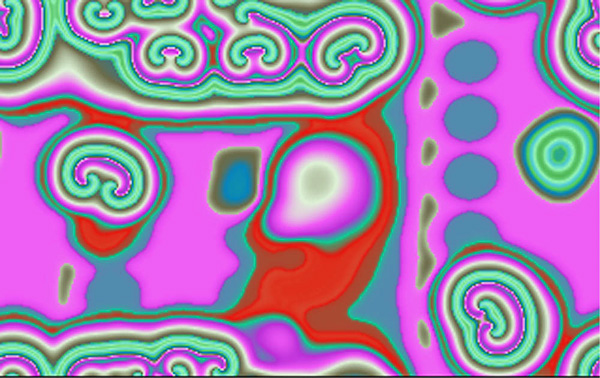
And here’s a pattern of cellular automata that underlies the year 3000 disco. This is what our world is like a smooth field of quantum computation. That’s all that’s there. And we only interpret the patterns as being things like green potatoes and dancing ducks?
And after the year 3000? Perhaps we leave our bodies and turn into light. Or maybe into subdimensional jellyfish, as I discuss in my novel Mathematicians in Love.
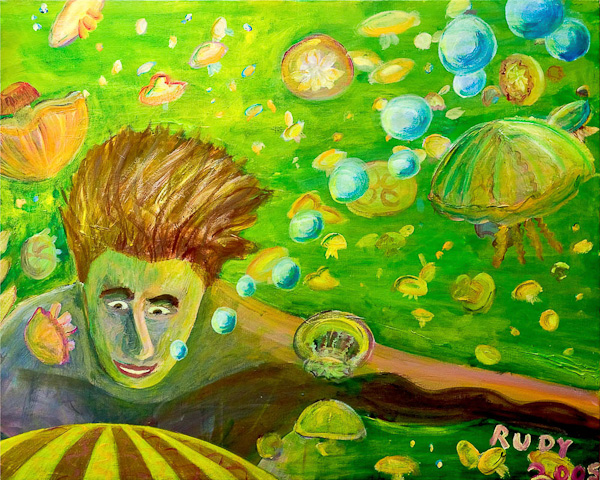
I’ll see you there!









November 15th, 2011 at 10:32 am
Great stuff, Rudy; you’re gonna knock ’em dead. Is this going to be your slideshow?
November 15th, 2011 at 5:57 pm
Thanks, Steve. Yeah, these are my slides. I’ve gone away from using text on the slides for talks. I like the kind of approach I use in my blog of letting suggestive pictures rock along with what I’m saying. More fun for the audience that way, I think.
November 15th, 2011 at 6:21 pm
have phun!!
November 19th, 2011 at 4:50 am
Maybe the traditional SF airbrush cover for Software is a little out of tune with all the other great artwork?
Why not use the cover for the Japanese edition? It’s more in tune I think…
http://www.amazon.co.jp/gp/product/images/4150108404
November 19th, 2011 at 5:25 pm
without human consciousness the universe would be a wasteland of dead rocks, dirt and burning dirt and rocks. Even your books would be dead without being animated by the light of our consciousness.
November 20th, 2011 at 1:53 am
Glenn, My feeling is that hylozoism is an intriguing alternative to your viewpoint. Rather than saying that human consciousness is the light of the world, hylozoism suggests that the objects in the world are in some sense alive and conscious even without us. Like those cartoon dream scenes where a kid’s toys get up and do things on their own. I find it comforting to suppose that we’re not like fireflies in a dark warehouse, but rather like bubbles in a flowing stream.
November 21st, 2011 at 11:13 am
Religions are also comforting and they’ve caused almost all of our problems for god knows how long. But thanks for responding. I wish you well. BTW I think Saucer Wisdom WAS a novel and maybe your best AND most important. Been wanting to mention that for years. When was the last time you read it, rhetorically.
November 22nd, 2011 at 11:53 am
It’s a terrifying notion; if hylozoism is in any way true, then all these objects are in some way conscious and aware. Are they bored? Horrified? Do they talk to each other on a band we can’t tune in? Are my shoes worrying about my plan to replace them soon? Do they resent my daily walk along a dusty red dirt road? Maybe all the objects pity us and wish that they could somehow ‘wake us up.’ How long are their memories? Where would they store thoughts? Maybe we are a few red bubbles in a stream of blue ones which don’t notice us.
Senses are a problem too; we grew eyes so we could find food more efficiently, but a rock doesn’t have needs. Would hylozoic objects be functionally autistic, locked in their own worlds, or would they have a sense of other hylozoic things around them? A pebble would have no urges or needs, maybe not even a sense of self: petrified Zen masters. Would they be a billion voices shouting in the dark, or a steady hum of wordless communication? Perhaps they talk about mathematics, using tones to represent integers, and if we could eavesdrop we’d think it was a complicated Bach fugue. Glenn could invite them to jam, and communication would be achieved!
I get Glenn’s point, though; unless there’s a solid reason to think this is in fact true, it wavers over into the gray area of religion and faith. Person A wonders if it is true and begins to design experiments, while Person B knows it is true and founds a church. A year later Person B and his church lynch Person A for heresy . . .
November 26th, 2011 at 1:59 am
Hi Rudy,
Looking forward to seeing your TEDx talk from Brussels online. Jacques Vallees’ talk at the same conference has been circulating in my online circles and has been causing quite a bit of excitement (were you able to catch it? http://www.youtube.com/watch?v=S9pR0gfil_0 ). It basically seems to be a summary of some closing remarks he made in his 1989 book “Dimensions”, where he explains that information theory and physics are flip sides of the same coin. His angle seems to have been overlooked over the past few decades, but I could be wrong (I’m just an artist), but it fits in with a lot of the stuff that I’ve gleaned from your blog and books over recent years (from your Hylozoic series, to being tipped off to Panpsychism and Seth Lloyd’s work). Consciousness as a Google search or something… although there are plenty of people who think nothing has to be developed technologically to bring this about, but living in SoCal, none of that probably is news to you. Intriguing stuff all around, at any rate.
Cheers!
November 26th, 2011 at 2:06 am
Woops! Just noticed that there’s an update at the very beginning of the blog post with a link to your talk. I’ll pass it around.
November 27th, 2011 at 8:30 am
Your mention of hylozoism reminds me of a nifty article I read yesterday about the Indian polymath Sir Jagadish Chandra Bose [ http://thesmartset.com/article/article11221101.aspx ] and his explorations of plant physiology. After discovering plants’ responses to external stimuli could be measured and recorded, he became more and more interested in similarities of perception and awareness between plants and animals, and ultimately began investigating the possibility that inanimate matter might also display some forms of awareness/consciousness…
November 28th, 2011 at 12:15 am
Dear Rudy, I really enjoyed your Talk on Ted. It all makes sense to me as I have had visions of what it’s like for People on Earth in the Year 3000. If you are interested I’ve recounted these on my blog dimitiekendall.com. I couldn’t understand how it would be possible for people on earth to live in a structure that looked like a giant lotus flower. Now after seeing your talk, it all makes sense. Thank you for confirming that what I’m seeing may well possibly be what it’s like in the future.
Kind regards.
PS and yes I agree that our Iphones are the next step towards telepathy.
December 2nd, 2011 at 4:23 pm
Excellent talk! I listened to all the others and your talk was by far the most mind expanding.
Looked like a huge audience… 2000 people?
December 3rd, 2011 at 7:13 pm
Thanks for all the comments. I do like the idea of everything being alive in some sense. In a way, when you sculpt a rock, you’re programming its quantum state and therewith its mind. My feeling is that most objects are simply content to be humming along. Om. I have sometimes had the feeling of getting vibes from some objects, as if they had memories of their past interactions. Yes, there’s no compelling reason to believe this, but it’s a pleasant way to think. And, keeping in mind that quantum computations do pervade objects, there may yet be some solid basis for hylozoism.
Just today I ran across a blog post by Karl Schroeder suggesting that the reason we aren’t coming across advanced alien visitors is that, further down the line, civilizations go hylozoic, and you can no longer tell the aliens from ordinary natural objects. See his post at http://bit.ly/tLz6sp
The notion of information and physics is indeed interesting. Norm Margolus at MIT is one of the leading experts on these topics, see some of his papers and links at http://people.csail.mit.edu/nhm/
Closer in, I think there’s really no doubt we’ll be growing things instead of manufacturing them within a century or two. For a survey of how the past and future of gnarly computation might play out, see this excerpt of my Lifebox book:
http://www.rudyrucker.com/pdf/historyofgnarl.pdf
December 7th, 2011 at 10:09 pm
I wonder if, when people come up with a concept independently (I’ve only learned of hylozoism just now, from your blog) and both concepts agree strongly, doesn’t that add some weight to it? Over the past several years I’ve come to the conclusion that, like gravity, consciousness is built right into the fabric of the universe. It’s the simplest conclusion to a most complex puzzle. I postulate that everything 1) is made of information and, 2) is perfectly aware of what it is. Even the uncertainty principal hints at this. Assuming that we’re the only matter in the universe that is self-aware is like assuming our solar system is the only star in the universe with planets. It would then follow that the brain is not the seat of consciousness, merely the processor of consciousness.
December 8th, 2011 at 9:58 am
Jerry, I’m inclined to agree with you. It’s foolishly chauvinistic to think that consciousness can only reside in our particulay type of matter-meat. The interesting problem is, I think, to find some way to get an exchange going with things like plants and rocks. Although it may be that sculpting a rock or working a metal is as close as we ever get to “talking” to those things.
December 9th, 2011 at 1:14 am
I don’t feel on board with the optimistic future 989 years forward. Besides the possibilities of violence, what if we’re wrong about capitalism and democracy, or what if we’re right but they fail? I was reading about Ted Kaczynski’s motivations for the Unabomber killings: he believed that technology and progress create more hunger than they satisfy.
But the main reason I’m not on board with it, is a techno-utopia just seems to blossom too naturally from a flower-child who lived through the longest secular bull market the world has ever seen. My sense of equilibrium leans toward some dark periods over the next millennium. Not necessarily an apocalypse but communing with the atoms of the trees and rocks is just too cheery. Death Metal. Screamo. Sick Sad World. Gripes, qvetches, nags, and whining teenagers. Thanatos instinct.
One more quibble on a very entertaining talk: you really think people would choose such creative forms if they could? I think we would just try to look ever more like Christian Bale and Cameron Diaz. Maybe avatars in 2nd Life or WOW could prove me wrong, or maybe the star-bellied sneetches will take over after anyone can look like CB/CD.
Also — Is It Alive? by Farmer and Walter’s Grey Turtles (from virgil.gr) make me sceptical of the hylozoism stuff. Personally I’d draw a firmer boundary between computation and consciousness. If granite were doing interesting computations — it probably wouldn’t look like our conception of a rock.
December 9th, 2011 at 1:18 am
Jerry, I think the multiplicity of people hitting on these ideas just suggests that the precursor ideas are prevalent in our common idea-soup. James Gleick just put out this bestseller about Information. When a definable but unmeasurable concept like that starts showing up in economics (via the EMH), quantum mechanics (quantum communication, which I hear may be on its way out), thermo, consciousness (phi), complexity, evolution / pop genetics, and cryptography … you’ve got to wonder if we’re just deluding ourselves.
December 9th, 2011 at 1:20 am
Johnathan Roberts, is it a tenet of, um, Jainism? that plants have one sense whilst we have six? (or is it fourteen)
December 9th, 2011 at 8:35 am
Isomorphismes, thanks for the comments. I do tend to write and speculate about positive and happy futures, yes. Of course I’m not blind to the possibilities of horrible negative futures, but I guess I think these kinds of speculations are perhaps too easy to do, and somewhat boring, also very much over-represented in the kinds of articles one reads in the media. SF is, after all, sometimes known as an “escape literature,” and my preference is to escape to somewhere nice! I’d also suggest that speculating about positive outcomes can have a good effect on the paths that a society chooses.
December 9th, 2011 at 9:43 am
Rudy, I feel you on that. BTW, awesome drawings / imagination!
December 10th, 2011 at 6:42 pm
OK, I hunted down the links on φ. Consciousness is my friend’s personal life obsession so this may be too much material. Or, having taught AI, you might already know about all this!
Farmer & Belin “Is it alive?” lives at http://virgil.gr/19 as well as a bit on Walter Grey Turtles. A more sophisticated book on the same theme — is the difference in consciousness between us humans and some mindless robots just a difference of magnitude rather than a difference of kind? — would be Valentino Breitenberg’s book “Vehicles”.
The Koch / Tononi labs’ “Consciousness as Integrated Information” stuff seems to be calling Google Code home for the moment: http://code.google.com/p/consciousness. I haven’t read the whole Phi paper but it would seem to suggest that rocks are not conscious because they do not experience qualia. Or do they? Here’s the whole paper: http://www.biolbull.org/content/215/3/216.full. These are people for whom the letters NCC are not followed by -1701-D but rather stand for “Neural Correlates of Consciousness”.
Hope this is of interest.
December 11th, 2011 at 2:52 pm
@isomorphismes: That may be, however I’m not sure what to make of the idea that plants only have one sense. It doesn’t strike me as correct on an intuitive level. Plants have many different sense organs and ways of communicating/absorbing/reacting to energy of all sorts – touch/kinetic; biochemicals; different internal organs in and on leaves for diffusing light within individual cells; structures for regulating temperature, repelling, retaining or absorbing liquids and slurping up minerals; respond to sound and electromagnetic fields…
July 1st, 2012 at 9:32 pm
@Johnathan Roberts That is a great point. Convincingly said.